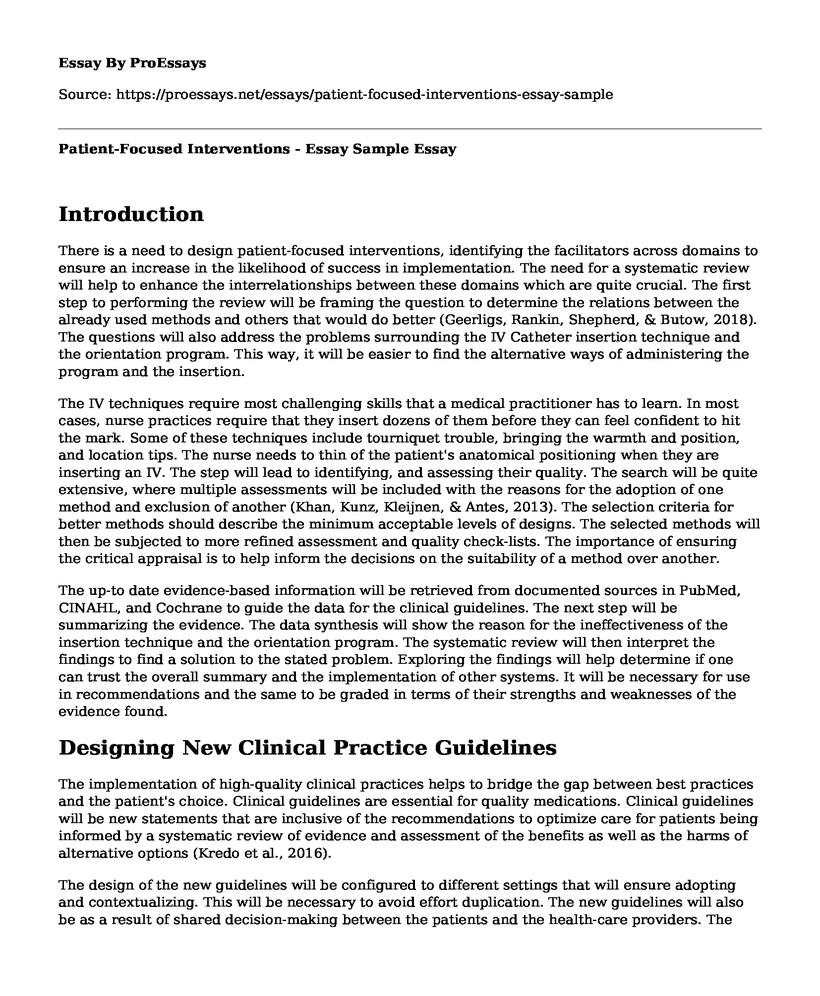Introduction
There is a need to design patient-focused interventions, identifying the facilitators across domains to ensure an increase in the likelihood of success in implementation. The need for a systematic review will help to enhance the interrelationships between these domains which are quite crucial. The first step to performing the review will be framing the question to determine the relations between the already used methods and others that would do better (Geerligs, Rankin, Shepherd, & Butow, 2018). The questions will also address the problems surrounding the IV Catheter insertion technique and the orientation program. This way, it will be easier to find the alternative ways of administering the program and the insertion.
The IV techniques require most challenging skills that a medical practitioner has to learn. In most cases, nurse practices require that they insert dozens of them before they can feel confident to hit the mark. Some of these techniques include tourniquet trouble, bringing the warmth and position, and location tips. The nurse needs to thin of the patient's anatomical positioning when they are inserting an IV. The step will lead to identifying, and assessing their quality. The search will be quite extensive, where multiple assessments will be included with the reasons for the adoption of one method and exclusion of another (Khan, Kunz, Kleijnen, & Antes, 2013). The selection criteria for better methods should describe the minimum acceptable levels of designs. The selected methods will then be subjected to more refined assessment and quality check-lists. The importance of ensuring the critical appraisal is to help inform the decisions on the suitability of a method over another.
The up-to date evidence-based information will be retrieved from documented sources in PubMed, CINAHL, and Cochrane to guide the data for the clinical guidelines. The next step will be summarizing the evidence. The data synthesis will show the reason for the ineffectiveness of the insertion technique and the orientation program. The systematic review will then interpret the findings to find a solution to the stated problem. Exploring the findings will help determine if one can trust the overall summary and the implementation of other systems. It will be necessary for use in recommendations and the same to be graded in terms of their strengths and weaknesses of the evidence found.
Designing New Clinical Practice Guidelines
The implementation of high-quality clinical practices helps to bridge the gap between best practices and the patient's choice. Clinical guidelines are essential for quality medications. Clinical guidelines will be new statements that are inclusive of the recommendations to optimize care for patients being informed by a systematic review of evidence and assessment of the benefits as well as the harms of alternative options (Kredo et al., 2016).
The design of the new guidelines will be configured to different settings that will ensure adopting and contextualizing. This will be necessary to avoid effort duplication. The new guidelines will also be as a result of shared decision-making between the patients and the health-care providers. The new guidelines will be intended to improve the effectiveness as well as the quality of care. It will decrease the variations found in clinical practices as the nurses can adhere to a plan and a schedule that is competent.
These guidelines will also provide benchmarks or standards against which other individuals can audit, provide comparison and improve the practices. The new system will ensure quality improvement initiatives because the informed recommendations are a basis for identifying measurable standards of care as well as core outcomes (Kredo et al., 2016).
The design will also take care of the ease of integration. The interventions will need to fit into the existing hospital system. The guidelines that will need the changing of standard processes could report some delays and gaps in the process of implementation, hence will be cut off. The use of action research methods will facilitate the process and enable staff to respond to concerns with timely interventions.
References
Geerligs, L., Rankin, N. M., Shepherd, H. L., & Butow, P. (2018). Hospital-based interventions: a systematic review of staff-reported barriers and facilitators to implementation processes. Implementation Science, 13(1), 36. Retrieved from https://implementationscience.biomedcentral.com/articles/10.1186/s13012-018-0726-9
Khan, K. S., Kunz, R., Kleijnen, J., & Antes, G. (2013). Five steps to conducting a systematic review. Journal of the royal society of medicine, 96(3), 118-121. Retrieved from https://www.ncbi.nlm.nih.gov/pmc/articles/PMC539417/
Kredo, T., Bernhardsson, S., Machingaidze, S., Young, T., Louw, Q., Ochodo, E., & Grimmer, K. (2016). Guide to clinical practice guidelines: the current state of play. International Journal for Quality in Health Care, 28(1), 122-128. Retrieved from https://www.ncbi.nlm.nih.gov/pmc/articles/PMC4767049/
Cite this page
Patient-Focused Interventions - Essay Sample. (2023, Mar 13). Retrieved from https://proessays.net/essays/patient-focused-interventions-essay-sample
If you are the original author of this essay and no longer wish to have it published on the ProEssays website, please click below to request its removal:
- Essay Sample on Nutrition and Obesity
- Essay Sample on Open System Theory in Nursing
- Essay Sample on Public Health and Environmental Interaction: Essential Waste Disposal Strategies
- Essay on MA: Assessing Ecosystem Services for Human Well-Being
- Paper Example on IAVs: The Growing Threat of Zoonotic Diseases
- Essay Example on Accessibility for People with Disabilities: A Global Challenge
- Essay Example: Improving Health Information Management for Children with Tracheotomy







